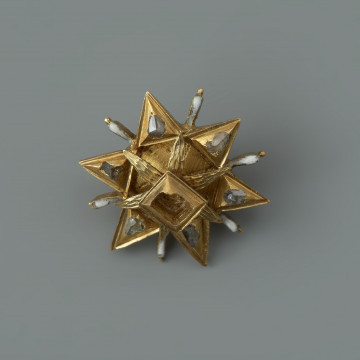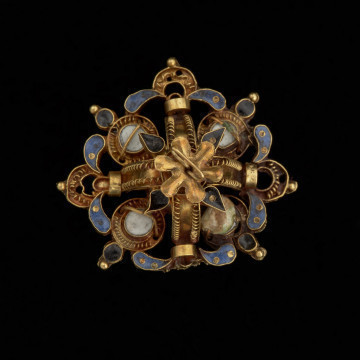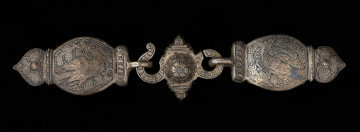
Star-shaped dress jewellery
nie po 1637
National Museum in Szczecin
Part of the collection: Jewels and costumes of Pomeranian dukes
Pomeranian Duke Francis I died on 27 November 1620. Shortly after his death, his body was dressed in a rich outfit consisting of a tight vambrace and knee-length, richly creased trousers of brocaded gold and black fabric with a floral pattern. The collar and cuffs were made of delicate white lace. Golden yellow silk stockings were tied below the knees with wide garters of black silk, finished with golden lace. The cap on the Duke's head was decorated with a row of colourfully enamelled golden rosettes with diamonds and pearls and a diamond-studded aigrette supporting a bunch of black heron feathers. The dazzlingly rich outfit also included jewellery: a medallion with a portrait of the Elector of Saxony John George I and two Saxon badges, an IHS jewel, a pair of bracelets with thee armour-like weave and rings. For two days, the Duke's corpse remained in his chamber, and then it was transferred in solemn procession to the great hall, where a catafalque covered with a cuirass was placed, with a cushion filled with fragrant herbs. The hall, like other chambers, and the interior of the Castle Church were decorated with black cloth as a sign of mourning. The Duke's body was on public display in the Castle great hall for almost seven weeks, and appointed courtiers kept vigil by his side day and night. During that time, preparations were made for the main ceremonies, the tin sarcophagus was made, orations were composed, and the family and other courts were notified of the funeral date. The importance attached to the presentation of the deceased ruler is evidenced by the detailed descriptions of his clothes, jewels and representative posthumous portraits, in which all the details of his attire were rendered with great accuracy, including the rosettes decorating the Prince's cap.
Monika Frankowska-Makała
Author / creator
Dimensions
cały obiekt: height: 2,3 cm, width: 4,2 cm
Object type
headgear adornment, jewellery
Creation time / dating
Creation / finding place
Identification number
Location / status

nie po 1637
National Museum in Szczecin

nie po 1637
National Museum in Szczecin

około 1600
National Museum in Szczecin
DISCOVER this TOPIC
National Museum in Szczecin
DISCOVER this PATH
Educational path